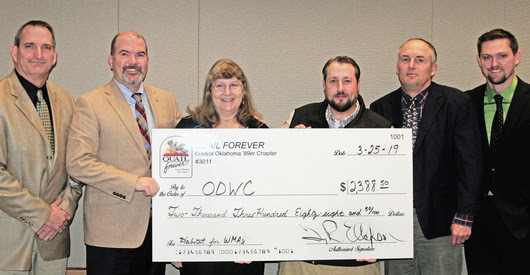
The Oklahoma Wildlife Conservation Commission voted March 25 to expand the state's black bear hunting area to include all areas south of Interstate 40 and east of U.S. 69, and to prohibit the harvest of bears with research collars.
In considering the annual slate of rule change proposals, Commissioners also decided to open raccoon harvest year-round, remove harvest limits for farm ponds, and authorize the Director to implement chronic wasting disease management actions as necessary.
Several proposals were amended, including one that would have eliminated permanent (entire-season) waterfowl blinds on many lakes. Instead, Commissioners decided to continue the usual duck blind drawings this September but evaluate the practice further and reconsider the issue next year.
The rule changes approved by Commissioners will now go to Gov. J. Kevin Stitt for approval before being added to Title 800 of Oklahoma’s Statutes, which governs the operations of the Oklahoma Department of Wildlife Conservation. The changes were proposed in December and went through a public comment period.
Pending final approval, hunters will be able to pursue bears this year in all of Haskell and Choctaw counties, and portions of Bryan, Atoka, Pittsburg, McIntosh, Muskogee and Sequoyah counties, in addition to the existing open area of Latimer, Le Flore, McCurtain and Pushmataha counties.
To help protect Oklahoma’s native deer and elk populations from the threat of chronic wasting disease, Commissioners approved a restriction on importing, possessing or transporting any cervid carcass or part of a cervid carcass from outside Oklahoma except quarters or meat with all spinal material removed, cleaned teeth, finished taxidermy products, and hides or tanned products. An amendment to the proposal will allow cervid heads to be brought into Oklahoma if new restrictions are followed. Those restrictions are to be developed soon.
Commissioners OK’d opening Okmulgee County and several wildlife management areas for fall turkey hunting season, deleted the requirement to complete the “Harvest of Game” for many species, and approved regulations for the new Neosho WMA and Thomas A. Bamberger Sr. WMA.
Also during Monday’s meeting, a five-year strategic plan setting goals for the Wildlife Department gained Commission approval. Director J.D. Strong said 22 years have passed since the Department’s strategic plan was updated. After months of effort that sought to involve all employees, the plan will serve to define and prioritize the work of the Department and strengthen agency accountability.
In other business, Commissioners:
- Viewed a status report from Dave Kostersky of Ducks Unlimited Canada on Department contributions toward waterfowl production. Commissioner Bruce Mabrey suggested the Department increase its $75,000 annual commitment to DU Canada, since more than 38 percent of the state’s fall flight originates in Saskatchewan.
- Accepted a $2,388 donation from the Central Oklahoma 89er Chapter of Quail Forever for upland game conservation tools. Chapter President John Bellah said leveraging the donation with federal matching grants will generate almost $10,000 to help fund Department management activities.
- Received an update from John Weir and Russell Stevens of the Oklahoma Prescribed Burn Association on activities partly funded by the Wildlife Department. Prescribed burning is among the best tools land managers can use to improve wildlife habitat.
- Learned that the Oklahoma Wildlife Conservation Foundation had gained approval from the Internal Revenue Service to operate as a 501(c)(3) nonprofit charitable organization.
- Heard Director Strong’s regular report on various division activities in the Department, including a report that the Fisheries Division stocked more than 15 million fish into Oklahoma waters in the past year.
The Oklahoma Wildlife Conservation Commission is the eight-member governing board of the Oklahoma Department of Wildlife Conservation. The Commission establishes state hunting and fishing regulations, sets policy for the Wildlife Department and indirectly oversees all state fish and wildlife conservation activities. Commission members are appointed by the governor and confirmed by the Oklahoma Senate.
The next scheduled Commission meeting will be 9 a.m. Monday, May 6, 2019, at the Department headquarters, 1801 N. Lincoln Blvd., Oklahoma City.